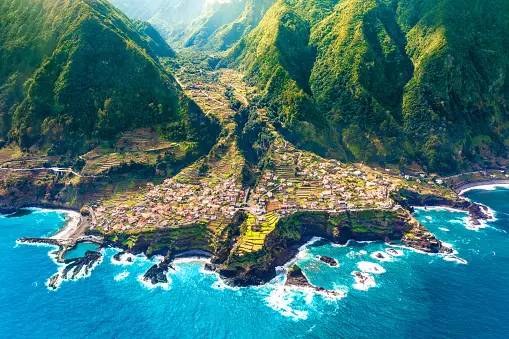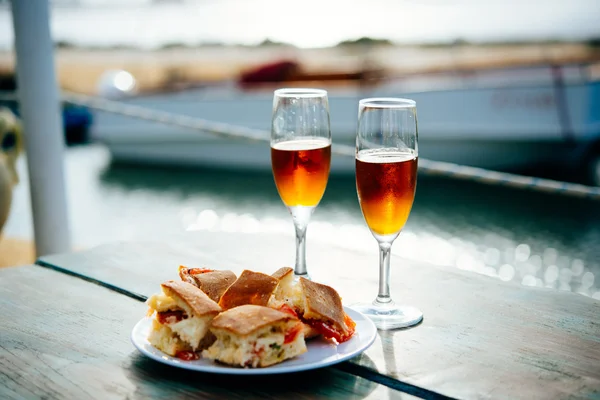Dessert wines, so-called stickies that most people agonize over, don't easily fit into a meal or a wine event.
Planning a meal with multiple wines, the challenge with dessert wine is its often too sweet as an aperitif or cocktail wine, although Port is a favorite aperitif wine in France. And, with the possible exception of Sauternes and Barsac, dessert wines are usually not the best choice with the entree.
Serve a rich, gooey chocolate dessert to an American and you have a happy person. But if you present a dessert wine with a sweet dessert, instead of as dessert, you're asking for a clash of the sugars.
It's a dilemma that some gladly embrace, while others just as gladly ignore. There's no secret formula or strategy for deciding when to enjoy a dessert wine, but a good place to start is to consider Madeira, Marsala and Malaga, the 3Ms of dessert wine.
 |
| Clinging terraced vineyards on Madeira |
Madeira is an historic dessert wine, with an American connection. Madeira comes from the Portuguese island of the same name, floating in the Atlantic Ocean, closer to North Africa than it is to Portugal.
At the end of the 18th century, American colonists were importing enough Madeira, that the new country became a major export market for Madeira. So popular was Madeira in the colonies, that it was used to toast the Declaration of Independence in 1776.
Madeira is a fortified wine. That is, at a specified stage of fermentation, grape spirit is added, arresting the fermentation, resulting in a sweet fortified wine with about 20% alcohol. An examination of old records, though, reveals that Madeira likely started as a non-fortified wine.
Production of Madeira is centered around artificial "aging" in an estufa, a special room, heated by an outside source or by warm water circulating through a network of pipes inside the room. Barrels or lodge pipes (145-200 gals.) of Madeira are stored in the rooms, heating the wine until it attains a yellow-brown color and a nutty/prune aroma. Modern estufagem use stainless steel tanks heated by an external system of hot-water pipes.
At the top of the grape list for Madeira is Tinta Negra, a red-skinned variety that grows well in the island's fertile soils. Additionally, there are five traditional white grapes used to make Madeira: Boal, Malvasia, Sercial, Terrantez and Verdelho. A few American hybrids are grown for making local dry table wine.
All, or some, of these grapes are used in the following styles, roughly from dry to sweet: Sercial, Verdelho, Boal, Malmsey. Special historic styles, like Rainwater, remain popular, while the latest types of Madeira include an indication of age (10-Year), Colheita and Vintage.
 |
| Marsala and a Sicilian snack |
Marsala is an Italian fortified sweet wine, from the province of Trapani, on the island of Sicily. Unlike the origin story of Madeira, Marsala owes its beginnings to one Englishman, named Woodhouse, who thought the local wine made around Trapani was similar to Port and Madeira. So, he fortified the wine and shipped it to England where Marsala became an instant hit with his fellow countrymen.
The base wine for Marsala comes from Sicily's traditional white grapes: Grillo, Cataratto and Inzolia (See "Sicilian White Wine," July 19, 2024). Marsala is made either by adding grape spirit, or by increasing the alcohol level through the infusion of mistela, a high-sugar grape juice, similar to Germany's süssreserve.
There are three main styles of Marsala: Fine, made with the addition of grape spirit, mistela and one year of cask aging; Superiore, only mistela and two years of cask aging; Vergine, a dry style with no mistela and at least five years of cask aging.
Marsala has suffered indignities in years past, including the addition of "special flavorings such as chocolate, almonds and eggs. After years of poor quality and shrinking sales, Marsala has turned the corner and the "special" styles of Madeira are no longer allowed to be labeled as DOC Madeira.
| General Jose de San Martin, hearing the tasting results |
Malaga, is a Spanish dessert wine from the sun-drenched province of Andalucia. Malaga traces its history back to Moorish occupation of the land. By the 18th century, with the Moors gone, Malaga was openly exported worldwide.
At what may have been the first "blind" wine tasting, Argentine General San Martin asked his dinner guests to taste one of his favorite Mendoza wines against the reputation of a Malaga. The general's wine game reportedly boosted the reputation of Mendoza wine.
In Andalucia, Muscat of Alexandria and Pedro Ximenez ripen to high sugar levels, maxing out at 14% residual sugar. At one time, Malaga was made by drying the grapes in the sun on grass mats to concentrate the grape sugars.
Today, the Malaga technique is to stop fermentation by adding a mistela, the sweet juice of late-harvest sun-dried Moscatel, or by adjusting the sweetness with arrope, the process where unfermented grape juice is boiled down to 30% its normal volume, then added to the fermenting wine.
Aged Malaga matures in oak barrels, arranged in a solera, similar to the fractional blending system popularized in the Sherry region of Andalucia. Spanish law allows an impressive 16 types of Malaga, from Seco (dry) to Sweet, gradated on different levels of residual sugar. Additionally, there is a golden Dorado (no arrope) and Negro (at least 15% arrope).
The taste of Malaga is defined by concentration and ripeness. With Malaga, and Marsala more than Madeira, sweetness is secondary. The essence of good Malaga is raisiny, with underlying spice and subtle caramel. Sufficient acidity assures Malaga will be sweet but not cloying.
A small glass of Madeira, Marsala or Malaga, is a great way to end a meal. Lighter and less filling than a heavy dessert, one of the 3M's of dessert wine satisfies the craving for something sweet, after a meal.
Next post: Beaujolais and Respect
Contact me at boydvino707@gmail.com



No comments:
Post a Comment
Note: Only a member of this blog may post a comment.